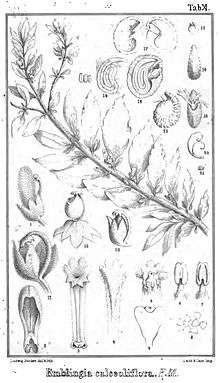Emblingia
Emblingia is a monospecific plant genus containing the species Emblingia calceoliflora, a herbaceous prostrate subshrub endemic to Western Australia. It has no close relatives, and is now generally placed alone in family Emblingiaceae.
| Emblingia | |
|---|---|
 | |
| Scientific classification | |
| Kingdom: | Plantae |
| Clade: | Tracheophytes |
| Clade: | Angiosperms |
| Clade: | Eudicots |
| Clade: | Rosids |
| Order: | Brassicales |
| Family: | Emblingiaceae (Pax) Airy Shaw |
| Genus: | Emblingia F.Muell. |
| Species: | E. calceoliflora |
| Binomial name | |
| Emblingia calceoliflora | |
Description
It is a perennial, herbaceous prostrate subshrub, with simple petiolate leaves with "cartilaginous" (hard and tough, resembling cartilage) margins. The irregular, solitary flowers are white, cream, yellow, green or, pink, and occur from August to November. It has a non-fleshy fruit.[1][2][3][4]
Taxonomy
The genus and species were first published in 1861 by Ferdinand von Mueller in Fragmenta Phytographiae Australiae, based on specimens collected in the Murchison region by Pemberton Walcott and Augustus Frederick Oldfield.[5][6]
Placement of the genus within a family has previously been considered a difficult problem; it has at various times been placed in Capparaceae, Sapindaceae, Goodeniaceae and, in the Cronquist system, Polygalaceae.[7] In 1965, Herbert Kenneth Airy Shaw erected Emblingiaceae for the genus, and that family is now used for the genus in the APG II, Dahlgren, Reveal, Stevens, Takhtajan and Thorne systems.[8] Molecular analyses have confirmed the genus's placement in the Brassicales.[7][9]
Distribution and habitat
It is endemic to Western Australia, occurring in grey, yellow or red sand, on undulating sandplains of the west coast. It is most common in the Geraldton Sandplains and Carnarvon biogeographic regions, but also occurs on the north western edge of the Avon Wheatbelt.[4]
Ecology
It is not considered to be threatened.[4]
References
- Watson, L.; M. J. Dallwitz (1992). "Emblingiaceae". The families of flowering plants: descriptions, illustrations, identification, and information retrieval. Archived from the original on 2007-03-11. Retrieved 2007-05-12.
- "Emblingiaceae". FloraBase. Western Australian Government Department of Parks and Wildlife.
- "Emblingia". FloraBase. Western Australian Government Department of Parks and Wildlife.
- "Emblingia calceoliflora". FloraBase. Western Australian Government Department of Parks and Wildlife.
- "Emblingia". Australian Plant Name Index (APNI), IBIS database. Centre for Plant Biodiversity Research, Australian Government.
- "Emblingia calceoliflora". Australian Plant Name Index (APNI), IBIS database. Centre for Plant Biodiversity Research, Australian Government.
- Chandler, Gregory T.; Randall J. Bayer (2000). "Phylogenetic placement of the enigmatic Western Australian genus Emblingia based on rbcL sequences". Plant Species Biology. 15: 57–72. doi:10.1046/j.1442-1984.2000.00024.x.
- "USDA - APHIS - Concordance of Family Names: E". Archived from the original on 2007-02-11. Retrieved 2007-05-12.
- Hall, Jocelyn C.; Hugh H. Iltis & Kenneth J. Sytsma (2004). "Molecular phylogenetics of core Brassicales, placement of orphan genera Emblingia, Forchhammeria, Tirania, and character evolution". Systematic Botany. 29 (3): 654–669. doi:10.1600/0363644041744491.
Further reading
- Mueller, Ferdinand von (1861) Fragmenta Phytographiae Australiae 2(15).
- Shaw, H. K. Airy (1965) Kew Bulletin 18:257.
- Erdtman, G.; Leins, P.; Melville, R.; Metcalfe, C.R. (1969). "On the relationships of Emblingia". Journal of the Linnean Society. 67 (2): 169–186. doi:10.1111/j.1095-8339.1969.tb01963.x.
- Keighery, Greg (1981). "The breeding system of Emblingia". Plant Systematics and Evolution. 137 (1–2): 63–65. doi:10.1007/BF00983205.